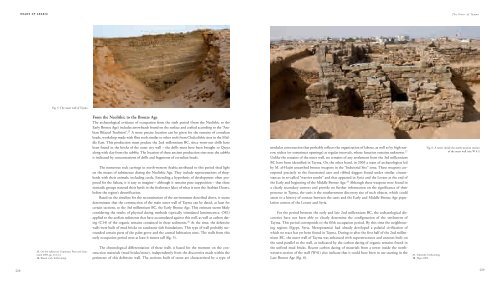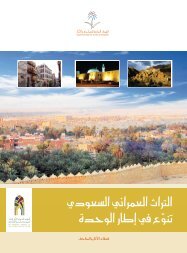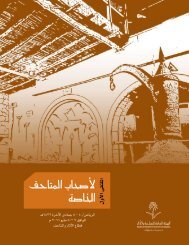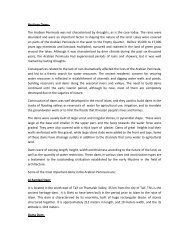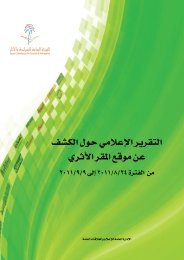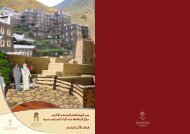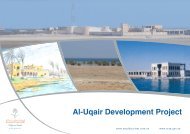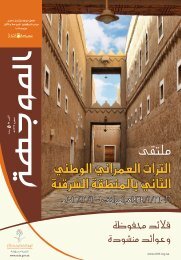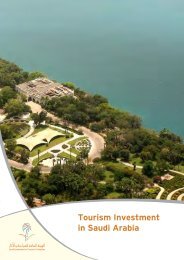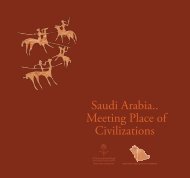Roads of Arabia
Roads of Arabia
Roads of Arabia
Create successful ePaper yourself
Turn your PDF publications into a flip-book with our unique Google optimized e-Paper software.
14 Arabie US_p218-261.qxd 23/06/10 21:51 Page 228<br />
ROADS OF ARABIA<br />
The Oasis <strong>of</strong> Tayma<br />
Fig. 5. The outer wall <strong>of</strong> Tayma<br />
25. On this subject see Uerpmann, Potts and Uerpmann<br />
2009, pp. 212–14.<br />
26. Klasen et al., forthcoming.<br />
From the Neolithic to the Bronze Age<br />
The archaeological evidence <strong>of</strong> occupation from the sixth period (from the Neolithic to the<br />
Early Bronze Age) includes arrowheads found on the surface and crafted according to the “<strong>Arabia</strong>n<br />
Bifacial Tradition”. 25 A more precise location can be given for the remains <strong>of</strong> cornelian<br />
beads, workshop-made with flint tools similar to other tools from Chalcolithic sites in the Middle<br />
East. This production must predate the 2nd millennium BC, since worn-out drills have<br />
been found in the bricks <strong>of</strong> the outer city wall – the drills must have been brought to Qraya<br />
along with clay from the sabkha. The location <strong>of</strong> these ancient production sites near the sabkha<br />
is indicated by concentrations <strong>of</strong> drills and fragments <strong>of</strong> cornelian beads.<br />
The numerous rock carvings in north-western <strong>Arabia</strong> attributed to this period shed light<br />
on the means <strong>of</strong> subsistence during the Neolithic Age. They include representations <strong>of</strong> shepherds<br />
with their animals, including cattle. Extending a hypothesis <strong>of</strong> development <strong>of</strong>ten proposed<br />
for the Sahara, it is easy to imagine – although it remains pure supposition – that these<br />
nomadic groups watered their herds in the freshwater lakes <strong>of</strong> what is now the <strong>Arabia</strong>n Desert,<br />
before the region’s desertification.<br />
Based on the timeline for the reconstitution <strong>of</strong> the environment described above, it seems<br />
determinant that the construction <strong>of</strong> the main outer wall <strong>of</strong> Tayma can be dated, at least for<br />
certain sections, to the 3rd millennium BC, the Early Bronze Age. This estimate seems likely<br />
considering the results <strong>of</strong> physical dating methods (optically stimulated luminescence, OSL)<br />
applied to the aeolian sediments that have accumulated against this wall, as well as carbon dating<br />
(C14) <strong>of</strong> the organic remains contained in these sediments. 26 At the time, the defensive<br />
walls were built <strong>of</strong> mud bricks on sandstone slab foundations. This type <strong>of</strong> wall probably surrounded<br />
certain parts <strong>of</strong> the palm grove and the central habitation zone. The walls from this<br />
early occupation period were at least 6 metres tall (fig. 5).<br />
The chronological differentiation <strong>of</strong> these walls is based for the moment on the construction<br />
materials (mud bricks/stone), independently from the discoveries made within the<br />
perimeter <strong>of</strong> this defensive wall. The sections built <strong>of</strong> stone are characterized by a type <strong>of</strong><br />
modular construction that probably reflects the organization <strong>of</strong> labour, as well as by high narrow<br />
niches (or sometimes openings) at regular intervals, whose function remains unknown. 27<br />
Unlike the remains <strong>of</strong> the outer wall, no remains <strong>of</strong> any settlement from the 3rd millennium<br />
BC have been identified in Tayma. On the other hand, in 2003 a team <strong>of</strong> archaeologists led<br />
by M. al-Hajiri unearthed bronze weapons in the “Industrial Site” zone. These weapons correspond<br />
precisely to the fenestrated axes and ribbed daggers found under similar circumstances<br />
in so-called “warrior tombs” and that appeared in Syria and the Levant at the end <strong>of</strong><br />
the Early and beginning <strong>of</strong> the Middle Bronze Age. 28 Although these weapons were found in<br />
a clearly secondary context and provide no further information on the significance <strong>of</strong> their<br />
presence in Tayma, the oasis is the southernmost discovery site <strong>of</strong> such objects, which could<br />
attest to a history <strong>of</strong> contact between the oasis and the Early and Middle Bronze Age population<br />
centres <strong>of</strong> the Levant and Syria.<br />
For the period between the early and late 2nd millennium BC, the archaeological discoveries<br />
have not been able to clearly determine the configuration <strong>of</strong> the settlement <strong>of</strong><br />
Tayma. This period corresponds to the fifth occupation period. By this time the neighbouring<br />
regions (Egypt, Syria, Mesopotamia) had already developed a palatial civilization <strong>of</strong><br />
which no trace has yet been found in Tayma. During or after the first half <strong>of</strong> the 2nd millennium<br />
BC, the outer wall <strong>of</strong> Tayma was enhanced with superstructures and annexes built on<br />
the sand parallel to the wall, as indicated by the carbon dating <strong>of</strong> organic remains found in<br />
the unfired mud bricks. Recent carbon dating <strong>of</strong> materials from a tower inside the northwestern<br />
section <strong>of</strong> the wall (W41) also indicate that it could have been in use starting in the<br />
Late Bronze Age (fig. 6).<br />
27. Schneider, forthcoming.<br />
28. Nigro 2003.<br />
Fig. 6. A tower inside the north-western section<br />
<strong>of</strong> the outer wall (site W 41)<br />
228<br />
229


